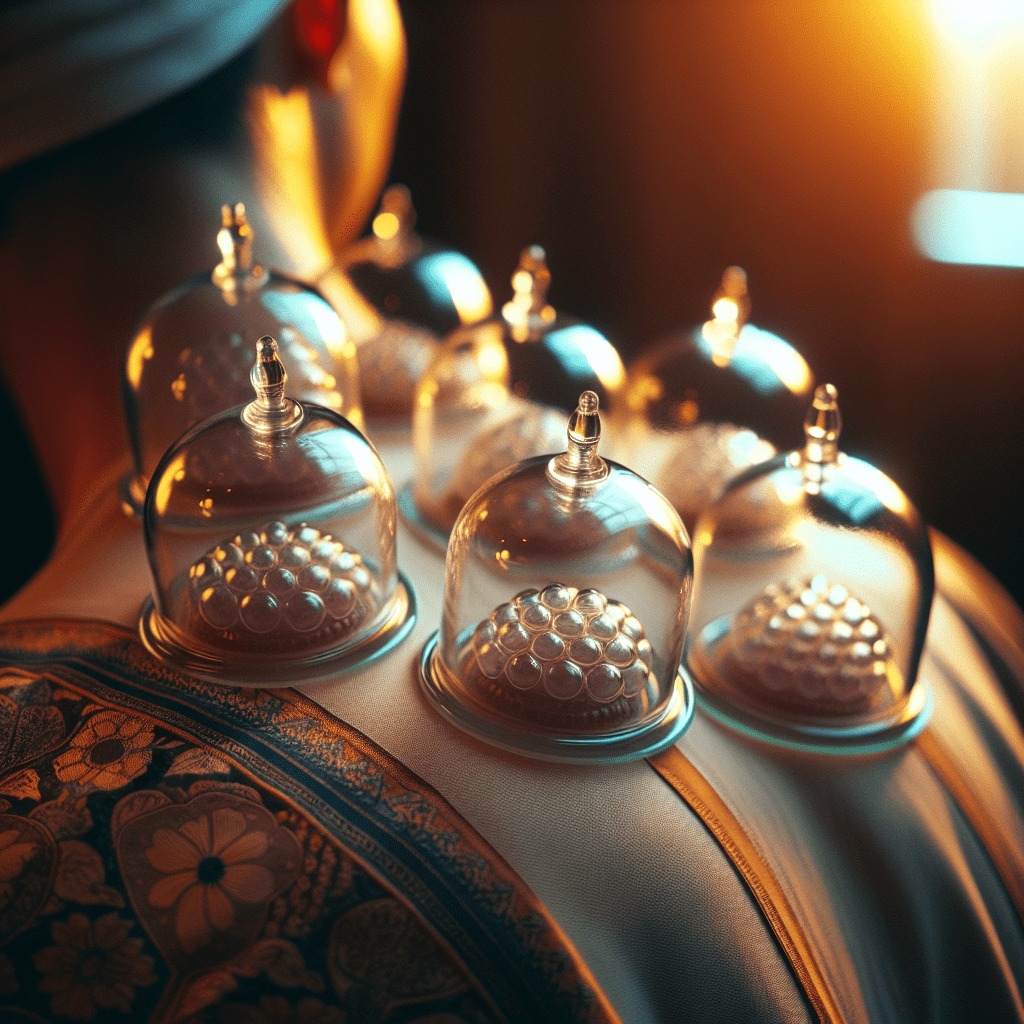In a world where modern medicine often takes center stage, there’s something truly fascinating about ancient healing practices making their way back into our wellness routines. One such practice that’s been turning heads (and backs!) is cupping therapy—an age-old treatment that’s experiencing a remarkable resurgence among health enthusiasts worldwide.
Dating back thousands of years to ancient Egyptian, Chinese, and Middle Eastern civilizations, cupping therapy has stood the test of time for good reason. This therapeutic technique involves creating suction on the skin using specially designed cups, drawing blood to the surface and potentially unlocking a host of health benefits. At HerbalsZen, we’re particularly intrigued by such traditional Eastern approaches that align perfectly with our philosophy of blending ancient wisdom with modern understanding.
The beauty of cupping therapy lies in its simplicity and the profound ways it connects to Eastern healing philosophies. Just as our EASTCHI AI system draws upon 2,000-year-old Eastern medical knowledge, cupping therapy taps into similar principles—focusing on energy flow, balance, and the body’s natural ability to heal itself when properly supported.
Dry Cupping vs Wet Cupping: Understanding the Basics
Dry Cupping: Think of this as the gentle introduction to the cupping world. Dry cupping involves placing cups on specific areas of your skin and creating a vacuum that pulls your skin slightly upward into the cup. This suction helps improve blood circulation to the area without breaking the skin. It’s a bit like giving your tissues a gentle lift and stretch from the inside!
The process typically involves either heating the air inside glass cups (traditional fire cupping) or using modern silicone or plastic cups with pumps to create suction. Once in place, the cups are usually left for 5-15 minutes, leaving those characteristic circular marks that athletes like Michael Phelps famously displayed during the Olympics.
Wet Cupping: Now, if dry cupping is the gentle introduction, wet cupping takes things a step further. Also known as “Hijama” in some traditions, wet cupping includes an additional step—after the initial suction, the practitioner makes tiny, shallow incisions on your skin, then reapplies the cups to draw out a small amount of blood.
If that sounds a bit medieval, think of it as a more targeted approach—somewhat like how a pressure valve releases built-up tension. The theory behind wet cupping is that it helps remove “stagnant blood” and toxins from the body, potentially offering deeper detoxification benefits than dry cupping alone.
To make these concepts more relatable, think of dry cupping as similar to a deep-tissue massage that works from the outside in, while wet cupping is more like a detox cleanse that works from the inside out. Both aim to restore balance, just through slightly different mechanisms.
The Visible Effects and Potential Benefits
But beyond the temporary marks, what can these different cupping methods do for your health?
Benefits of Dry Cupping:
- Promotes blood circulation to muscles and tissues
- Relieves tension and muscle tightness
- Reduces inflammation in specific areas
- Provides relaxation and stress relief
- May help with chronic pain conditions
According to recent research, dry cupping has shown promising results for various conditions. “Usually, clients approach dry cupping because the process reduces both persistent pain, as well as inflammation, and provides relaxation,” notes one study. This makes it particularly popular among athletes and those dealing with chronic muscle tension.
Benefits of Wet Cupping:
- May offer deeper detoxification effects
- Potentially removes harmful substances from the bloodstream
- Traditionally believed to clear “stagnant blood”
- Might offer more intensive treatment for certain conditions
- Some research suggests specific benefits for certain pain conditions
Interestingly, a 2022 review found that wet cupping (but not dry cupping) was effective specifically for low back pain, suggesting that different types of cupping might be better suited for different conditions.
From an Eastern medicine perspective, both methods work with the body’s energy pathways or “meridians.” This concept aligns perfectly with the Five Element Theory that forms the foundation of our EASTCHI AI approach at HerbalsZen. In Eastern healing traditions, cupping is believed to balance the body’s vital energy (qi or chi) and restore harmony between yin and yang forces.
The suction created during cupping is thought to open these energy pathways, allowing life force to flow more freely throughout the body. When energy flows properly, according to Eastern medicine, healing naturally follows.
Safety First: What You Need to Know
First and foremost, professional administration is absolutely crucial, especially for wet cupping. This isn’t a DIY project! Because wet cupping involves breaking the skin, it carries potential risks if not performed with proper sterilization and technique. Seeking out a licensed acupuncturist, traditional medicine practitioner, or trained cupping therapist is essential.
Here are some safety tips worth keeping in mind:
Check credentials: Ask about your practitioner’s training and experience specifically with cupping therapy.
Discuss your health history: Be upfront about any conditions you have, especially bleeding disorders, skin conditions, or if you’re taking blood thinners.
Start gentle: If you’re new to cupping, consider beginning with a lighter dry cupping session to see how your body responds.
Know the contraindications: Cupping isn’t recommended for everyone. It’s generally advised against for pregnant women, people with certain skin conditions like eczema or psoriasis, and those with open wounds or ulcers in the treatment area.
Expect some marks: Those circular marks are normal and temporary, but be prepared for them—especially if you have an event coming up where you’ll be showing skin!
Some people worry about the pain factor, but most describe the sensation as a strong pulling feeling rather than sharp pain. For dry cupping, many actually find it quite relaxing after the initial odd sensation. Wet cupping involves small incisions, so there is typically a bit more discomfort, but practitioners usually work to minimize this.
If you’re the squeamish type (no judgment here!), dry cupping might be your preferred starting point. As one practitioner humorously puts it: “Dry cupping is like dipping your toe in the water, while wet cupping is more of a cannonball into the deep end!”
Making Your Choice: Dry Cupping vs Wet Cupping
Consider dry cupping if:
- You’re new to Eastern therapies and want a gentle introduction
- You’re primarily seeking muscle relaxation and improved circulation
- You’re looking for a less invasive treatment option
- Your focus is on relieving specific areas of tension or discomfort
- You prefer minimal recovery time (though you’ll still have temporary marks)
Wet cupping might be worth exploring if:
- You’re familiar with Eastern medicine practices
- You’re specifically seeking detoxification benefits
- You’re comfortable with a more intensive procedure
- You’re dealing with certain chronic pain conditions (like that low back pain mentioned earlier)
- You’re open to traditional approaches to removing “stagnant” energy
Remember that this isn’t necessarily an either/or decision—many people incorporate both types of cupping at different times depending on their needs. The key is finding what works for your unique body and wellness journey.
At HerbalsZen, we recognize that personalization is central to effective wellness practices. Just as our EASTCHI AI system analyzes individual constitutional types to provide tailored recommendations, your approach to cupping should be equally personalized. The Eastern concept of treating each person according to their unique needs applies perfectly here.
Before making a decision, we encourage consulting with healthcare professionals who understand both Eastern and Western approaches. This integrative perspective ensures you’re making choices that support your overall health in a balanced way.
Embracing Ancient Wisdom in Modern Times
The resurgence of cupping in popular culture isn’t just a passing trend; it reflects a deeper shift toward holistic approaches that consider the whole person rather than isolated symptoms. This philosophy resonates deeply with what we stand for at HerbalsZen, where we’re constantly exploring how traditional Eastern healing wisdom can be applied meaningfully in today’s context.
What makes practices like cupping so valuable is their emphasis on supporting the body’s innate healing abilities rather than merely suppressing symptoms. In a world of quick fixes, these time-tested methods remind us that true wellness often comes through patience, balance, and respect for the body’s natural processes.
Whether you ultimately choose dry cupping, wet cupping, or decide cupping isn’t your cup of tea (pun intended!), the exploration itself is valuable. Understanding diverse approaches to health empowers you to make choices that truly resonate with your personal wellness philosophy.
As you consider integrating traditional practices like cupping into your routine, approach them with both an open mind and informed perspective. Ancient doesn’t automatically mean better, but these enduring methods have certainly earned their place in the conversation about holistic health.
In the end, the choice between dry cupping and wet cupping might indeed be harder than you initially thought—not because either is necessarily superior, but because both offer unique benefits worth considering on your wellness journey. And that journey, with all its fascinating twists and turns through both ancient wisdom and modern innovation, is exactly what makes the pursuit of well-being such a rich and rewarding experience.


